Financing an RV shares some similarities with financing other vehicles, such as cars or trucks; however, the process has quite a few differences. While this step might not be as exciting as other parts of the RV buying process, educating yourself with the right information will give you more confidence in your decision-making.
How Does Financing Work on an RV?
First, let’s take a look at how RV financing compares to traditional auto loans.
Loan Terms: While your typical auto loans offer financing for 12 to 84 months, you may find extended terms for RV financing. RV loan terms depend on various factors, including the age and value of the RV, and your creditworthiness. Terms of up to 120 months are fairly typical for purchasing a new travel trailer, while motorhomes and more expensive trailers may even be financed for 240 months.
Interest Rates: It’s fairly common to come across low interest rate automobile loans, sometimes as low as 3 percent or less. For RV financing, you aren’t as likely to find rates this low. Automobile manufacturers keep rates low in order to boost sales with better financing terms. RV manufacturers do not offer similar programs. Plus, banks have more restrictive underwriting rules for recreational vehicles. Your interest rate may be based on your location, creditworthiness, RV value, requested term, and other factors.
Zero-Down Financing: Similar to auto loans, you can apply for RV loans with no money down. This is slightly riskier since the value of your new RV may depreciate after you drive it off the lot. Whether or not you are asked to put money down will depend on where you have obtained your financing, your RV’s age and value, and your creditworthiness.

Is RV Financing Hard to Get?
Your current financial situation will weigh heavily in your financing offers. RV financing is not necessarily harder to get than auto financing, especially if you apply for a secured loan. A secured loan uses the RV as collateral, meaning it can be repossessed if you don’t make proper payments. Applying for an unsecured loan is more difficult, but may be necessary if you are buying an older trailer.
Dealer Financing vs. Bank Loans
Like with auto loans, some dealerships offer financing or help you obtain financing from a network of providers. Bank loans may be obtained through the dealership or directly from a bank. You should research your options before negotiating your purchase. More on this is covered below.
Used RV Loans
While you can buy a used RV for a cheaper purchase price, you may have more trouble financing a used RV than a new one. Some lenders, such as Good Sam and many traditional banks, do not offer financing on RVs manufactured more than 10 or 12 years ago. Keep this in mind if you are looking at used RVs.
If you’re purchasing an older rig, try to gather funds for a down payment. If you have 10 to 20 percent to put down, it will help offset expected depreciation and may provide enough security for a lender. Or, if you have good credit, you may qualify for an unsecured loan, which means the age of the rig isn’t a determining factor for approval.
Financing an RV for Full-Time Living
If you’re planning to live full-time in your RV, there are other considerations to note. One benefit is that your loan interest may be tax deductible since your RV is considered your primary residence. But one drawback is that not all lenders are willing to finance RVs for full-time living. This is partially due to the fact that you will no longer own a sticks-and-bricks home with a permanent address. Some lenders do finance for full-timers, so shop around for your best option.

You’ll need to have information about the RV you wish to finance (including the VIN, year, and model), as well as your personal financial information regarding debts, assets, and income history.
Dealers will often be open to reducing the price of an RV, sometimes by as much as 20 or 30 percent off the MSRP. However, this is not guaranteed. You can get the best price during the offseason (October to February) and on the previous year’s models when new models are released—the timing of this varies by manufacturer. In addition to negotiating the price, you may be able to negotiate the terms of the financing if you’re financing through the dealer. When going through a dealer you can also request add-ons, such as hitches, wireless observation cameras, extended warranties, and more.
One of the most important things to note is that it’s rare to select an RV to purchase, finance it, and drive it off the lot on the very same day. Once you apply for an RV loan, it can take 24 to 48 hours or more to get a decision. Plus, the dealer needs time to get the RV ready for you. The whole process can take a week or longer. Also, you should also expect to pay a financing fee, which may range from $100 to $500, depending on the lender.
Similar to automobiles, the value of your new RV will decrease the moment you drive it off the lot. Make sure you have the appropriate insurance to cover the amount you are financing.
What Should You Have with You When Applying?
You’ll need to have information about the RV you wish to finance (including the VIN, year, and model), as well as your personal financial information regarding debts, assets, and income history.
What’s Negotiable?
Dealers will often be open to reducing the price of an RV, sometimes by as much as 20 or 30 percent off the MSRP. However, this is not guaranteed. You can get the best price during the offseason (October to February) and on the previous year’s models when new models are released—the timing of this varies by manufacturer. In addition to negotiating the price, you may be able to negotiate the terms of the financing if you’re financing through the dealer. When going through a dealer you can also request add-ons, such as hitches, wireless observation cameras, extended warranties, and more.
What Else Should You Expect During the Process?
One of the most important things to note is that it’s rare to select an RV to purchase, finance it, and drive it off the lot on the very same day. Once you apply for an RV loan, it can take 24 to 48 hours or more to get a decision. Plus, the dealer needs time to get the RV ready for you. The whole process can take a week or longer. Also, you should also expect to pay a financing fee, which may range from $100 to $500, depending on the lender.
Similar to automobiles, the value of your new RV will decrease the moment you drive it off the lot. Make sure you have the appropriate insurance to cover the amount you are financing.
Tips for Financing Your RV
What’s a Good Credit Score for RV Financing?
In order to secure the best terms on an RV loan, aim for a credit score of 700 or above. Unfortunately, you may not get help by having a co-signer since many lenders do not allow them for RV loans. You may, however, have a co-buyer. This is generally a family member who lives at the same address.
What Other Factors Do Lenders Take into Account?
Aside from your credit score, lenders will look at your income history and debt-to-credit ratio, as well as the specs of the RV you are financing.
What Else Can You Roll into RV Financing?
Setting up a new RV often involves extra purchases, some of which can be rolled into the RV financing. Consider adding your hitch (if needed), any extended warranties, sales tax, or other purchases. Check on specifics with your dealer or lender and keep in mind that you don’t want to borrow too much above the value of the RV.
Where Can You Get an RV Loan?
Shopping around for an RV loan is recommended, and you’ll find various lenders that offer RV financing. Consider the terms, interest rates, and other associated fees to find the best option for you.

Lenders That Specialize in RVs
Some lenders primarily finance RVs. This list includes GreatRVLoan, Good Sam, Camping World, and LightStream, among others. Since RV loans are their specialty, they may offer longer terms or more favorable interest rates and options.
National Lenders
Similarly, many national lenders, including Mountain American Credit Union, Bank of the West, and Alliant Credit Union, offer RV financing.
Local Banks and Credit Unions
If you have a more personal relationship with your local lender, it may be a good option. Rates and options vary greatly depending on the lender. For example, some may limit RV loans to shorter monthly terms.
RV Shows
You can see different rig options at RV shows, and some dealers offer special pricing. At shows, the dealership can walk you through their financing options, and if one of them works for you, you can continue with the process then and there. Or, some buyers come to shows with an approved unsecured loan and have the cash in the bank needed for a purchase. If you want to use your own financing, you should pre-apply for a loan so you have a general budget. Finalizing the financing will then depend on the specific rig.
Other Associated RV Costs
Your RV loan is just one cost associated with owning a rig, so it’s important to understand other factors when budgeting for this expense. If you’re towing a trailer, you’ll need to think about the costs of setting up your tow vehicle. This includes towing equipment and mechanical equipment such as a brake control. Another cost to consider is insurance on the RV, which is likely a requirement when financing with a lender. Also, if you can’t store your RV at home, you need to consider storage fees. Additionally, don’t forget about saving for repairs and maintenance—while new RVs typically come with a manufacturer’s warranty, used RVs do not.
An RV is a major investment, but an understanding of RV financing will help you make the best decisions for your purchase. When you begin the process with patience and accurate information, you’ll be even closer to owning your dream rig.







